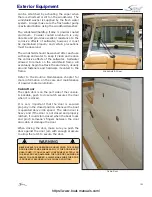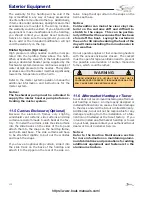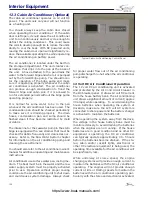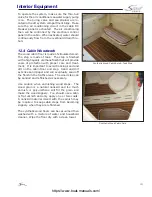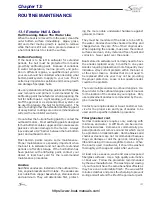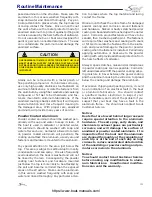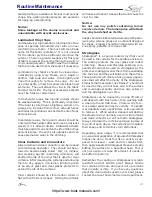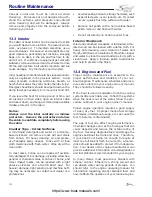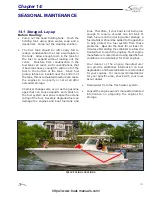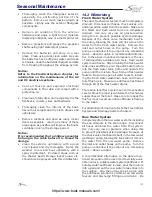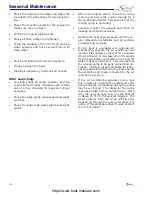
123
ROUTINE MAINTENANCE
13.1 Exterior Hull & Deck
Hull Cleaning-Below The Water Line
When the boat is removed from the water, clean the
outer bottom surface immediately. Algae, grass,
dirt and other marine growth is easier to remove
while the hull is still wet. Use a pressure cleaner or
a hard bristle brush to clean the surface.
Bottom Painting
If the boat is to be left in saltwater for extended
periods, the hull must be protected from marine
growth by antifouling paint. Because of variations
in water temperature, marine growth, and pollu-
tion in different regions, a qualified boat yard in
your area should be consulted when deciding what
bottom paint system to apply to your hull. This is
extremely important as pollution and marine growth
can damage fiberglass hulls.
Use only standard antifouling paints and fiberglass
wax removers and primers recommended by the
antifouling paint manufacturer when preparing the
hull for bottom paint. Light sanding, just enough to
scuff the gel coat or a skip sand primer system can
be used to prepare the hull for bottom paint. The
use of a coating other than standard antifouling paint
or epoxy barrier coatings are not recommended and
will void the hull blister warranty.
Do not allow the hull antifouling paint to contact the
outboard motors. Most antifouling paints designed
for hull bottoms contain copper and can cause severe
galvanic corrosion damage to the motors. Always
leave at least a 1/2” barrier between the hull bottom
paint and outboard motors.
Most bottom paints require some maintenance.
Proper maintenance is especially important when
the boat is in saltwater and not used for extended
periods or after dry storage. If the hull bottom has
been painted with antifouling paint, contact your
dealer or local boat yard for the recommended
maintenance procedures.
Anodes
Sacrificial anodes are installed on the outboard mo
-
tors, engine brackets and trim tabs. The anodes are
less noble than copper based alloys, stainless steel
and aluminum. They will deteriorate first, protect
-
ing the more noble underwater hardware against
galvanic corrosion.
They must be monitored if the boat is to be left in
the water. Anodes should be checked monthly and
changed when they are 75% of their original size.
When replacing the anodes, make sure the contact
surfaces are clean, shiny metal and free of paint and
corrosion. Never paint over the anode.
Boats stored in saltwater will normally need to have
the anodes replaced every 6 months to one year.
Anodes requiring replacement more frequently may
indicate a stray current problem within the boat or
at the slip or marina. Anodes that do not need to
be replaced after one year may not be providing
the proper protection. Loose or low quality anodes
could be the problem.
There are multiple anodes on outboard engines. You
should refer to the outboard engine owner’s manual
for the location of the anodes on your engines. Only
use replacement anodes recommended by the en-
gine manufacturer.
Contact your engine dealer or Scout Customer Ser-
vice for the proper size and type of anodes to be
used and the specific installation procedure.
Fiberglass Gel coat
Normal maintenance requires only washing with
mild soap and water. A stiff brush can be used on
the nonskid areas. Kerosene or commercially pre-
pared products will remove oil and tar which could
be a problem on trailered boats. Harsh abrasive and
chemical cleaners are not recommended because
they can damage or dull the gel coat, reducing its
life and making it more susceptible to stains. When
the boat is used in saltwater, it should be washed
thoroughly with soap and water after each use.
At least once a season, wash and wax all exposed
fiberglass surfaces. Use a high quality automotive
or boat wax. Follow the procedure recommended
by the wax manufacturer. The washing and waxing
of your boat will have the same beneficial effects as
they have on an automobile finish. The wax will fill
minute scratches and pores thus helping to prevent
soiling and will extend the life of the gel coat or paint.
Chapter 13:
https://www.boat-manuals.com/
Summary of Contents for 300 LXF
Page 2: ...2 Rev 0 Print Date 11 7 2016 https www boat manuals com ...
Page 8: ...8 NOTES https www boat manuals com ...
Page 12: ...12 NOTES https www boat manuals com ...
Page 18: ...18 NOTES https www boat manuals com ...
Page 27: ...27 Operation https www boat manuals com ...
Page 40: ...40 NOTES https www boat manuals com ...
Page 60: ...60 NOTES https www boat manuals com ...
Page 86: ...86 NOTES https www boat manuals com ...
Page 98: ...98 NOTES https www boat manuals com ...
Page 122: ...122 NOTES https www boat manuals com ...
Page 130: ...130 NOTES https www boat manuals com ...
Page 155: ...155 MAINTENANCE LOG Appendix C Date Hours Dealer Service Repairs https www boat manuals com ...
Page 156: ...156 Maintenance Log Date Hours Dealer Service Repairs https www boat manuals com ...
Page 157: ...157 Maintenance Log Date Hours Dealer Service Repairs https www boat manuals com ...
Page 158: ...158 Maintenance Log Date Hours Dealer Service Repairs https www boat manuals com ...
Page 159: ...159 Maintenance Log Date Hours Dealer Service Repairs https www boat manuals com ...
Page 160: ...160 Maintenance Log Date Hours Dealer Service Repairs https www boat manuals com ...
Page 161: ...161 Appendix D https www boat manuals com ...
Page 162: ...162 Boating Accident Report https www boat manuals com ...
Page 163: ...163 Boating Accident Report https www boat manuals com ...
Page 164: ...164 NOTES https www boat manuals com ...
Page 166: ...166 NOTES https www boat manuals com ...
Page 172: ...172 https www boat manuals com ...
Page 173: ...173 Scout Boats Inc 2531 Hwy 78 West Summerville SC 29483 https www boat manuals com ...

